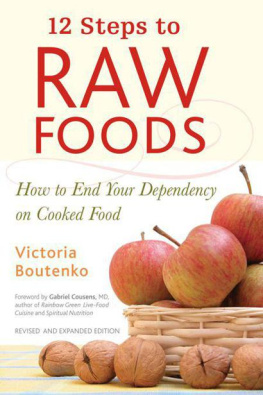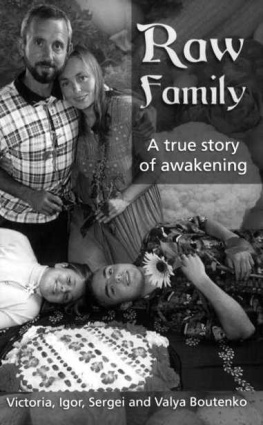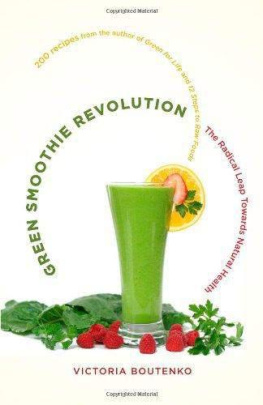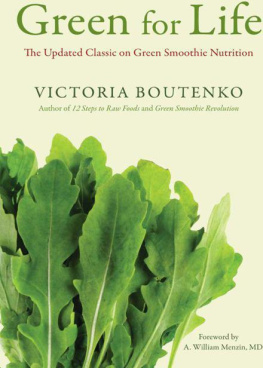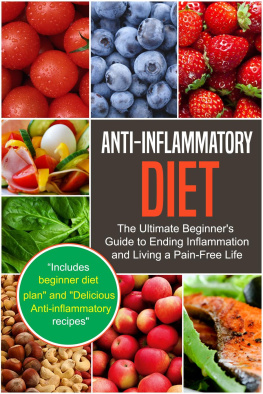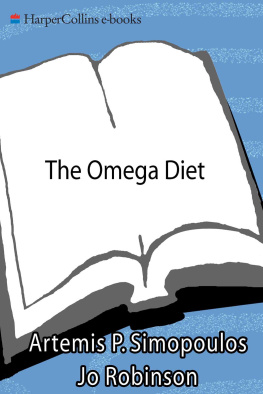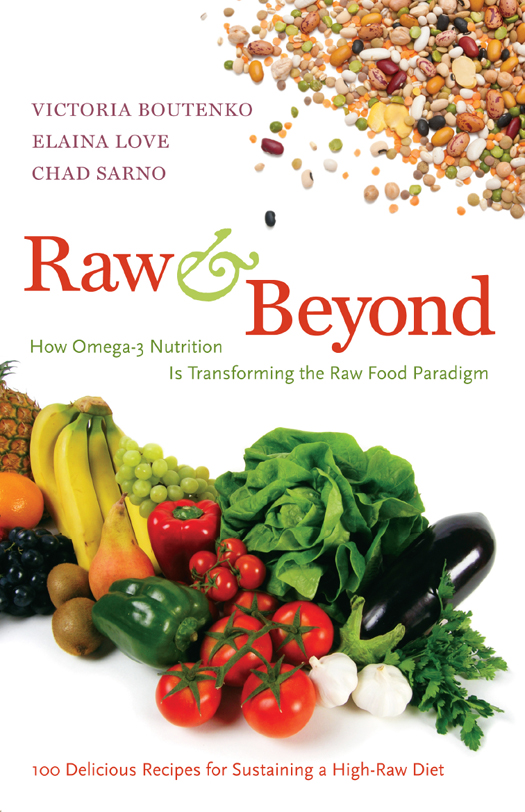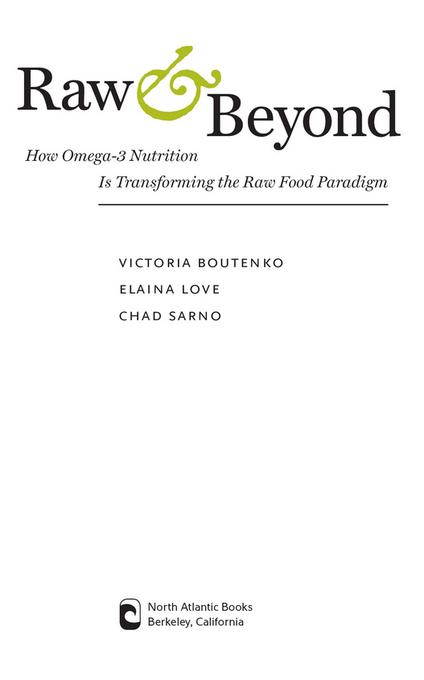ALSO BY VICTORIA BOUTENKO
Raw Family (with the Boutenko family)
Green for Life
12 Steps to Raw Foods
Raw Family Signature Dishes
Green Smoothie Revolution
Copyright 2012 by Victoria Boutenko, Elaina Love, and Chad Sarno.
All rights reserved. No portion of this book, except for brief review, may be reproduced, stored in a retrieval system, or transmitted in any form or by any meanselectronic, mechanical, photocopying, recording, or otherwisewithout the written permission of the publisher. For information contact North Atlantic Books.
Published by
North Atlantic Books
P.O. Box 12327
Berkeley, California 94712
Cover photo istockphoto.com/vm and istockphoto.com/Vitalina Rybakova
Cover design by Claudia Smelser
Raw and Beyond is sponsored by the Society for the Study of Native Arts and Sciences, a nonprofit educational corporation whose goals are to develop an educational and cross-cultural perspective linking various scientific, social, and artistic fields; to nurture a holistic view of arts, sciences, humanities, and healing; and to publish and distribute literature on the relationship of mind, body, and nature.
North Atlantic Books publications are available through most bookstores. For further information, visit our website at www.northatlanticbooks.com or call 800-733-3000.
MEDICAL DISCLAIMER: The following information is intended for general information purposes only. Individuals should always see their health care provider before administering any suggestions made in this book. Any application of the material set forth in the following pages is at the readers discretion and is his or her sole responsibility.
LIBRARY OF CONGRESS CATALOGING-IN-PUBLICATION DATA
Boutenko, Victoria.
Raw and beyond : how omega-3 nutrition is transforming the raw food paradigm / Victoria Boutenko, Elaina Love, and Chad Sarno.
p. cm.
eISBN: 978-1-58394-375-5
1. Raw food diet. 2. Vegetarian cooking. 3. High-omega-3 fatty acid dietRecipes. I. Love, Elaina. II. Sarno, Chad. III. Title.
RM237.5.B6925 2011
613.263dc23
2011036659
v3.1
We dedicate this book to Cherie Soria,
master chef and inspiration to us all.
CONTENTS
A NOTE FROM THE AUTHORS
In this book we present our revised approach to raw food. All three of us discovered the benefits of eating raw at about the same time, some sixteen years ago. Throughout this period, we often participated in the same events, either serving raw food or teaching others how to prepare it. In 2010, our paths crossed again at a Living Light Culinary Arts Institute in California. We were intrigued that we had all independently come to similar conclusions about our diets and had begun practicing beyond raw cuisine. As we discussed this coincidence, we decided it was important to share our adjusted raw food diet with our followers.
PART ONE
Three Stories of Raw Transformation
VICTORIA BOUTENKO
TWO MAJOR MISTAKES I MADE
IN MY RAW FOOD DIET
A life spent making mistakes is not only more honorable, but more useful than a life spent doing nothing. GEORGE BERNARD SHAW
For the last nineteen years I have been a raw food pioneer, and as a pioneer I recognize the mistakes Ive made as well as the successes Ive had on this path.
I became interested in the raw food diet in 1993. As there were very few books about raw food at that time, I was able to read most of them within a couple of months. I became especially inspired after reading Raw Eating by A. T. Hovannessian and Enzyme Nutrition by Edward Howell. The latter book I read aloud to my family. I became convinced that the raw food diet was the most natural diet for all creatures in the world, including humans.
In his book, Dr. Howell advised readers to consume a diet as high in raw food as possible. I was so motivated by Howells research, and my family was so in need of healing beyond what the medical establishment could offer us, that in January 1994 I put my whole family on a 100 percent raw food diet. Today, eighteen years later, I still wholeheartedly appreciate that decision. I believe that it saved my life and healed such serious illnesses in my family as arrhythmia, diabetes, rheumatoid arthritis, and asthma. I wont repeat my family story here as it can be found in all of my books and on the internet. Rather, I would like to discuss the mistakes I made in my raw food journey and how I corrected them. I view my familys eighteen years of eating raw as an opportunity to present the raw food diet to others in a more practical way.
For many years the theory of the raw food diet seemed so flawless to me that I couldnt find any errors in it. I was following a 100 percent raw food lifestyle and was trying to inspire as many others as possible to follow. Years later, to my surprise, I found major flaws hiding in two of my favorite statements:
Anything raw is superior to anything cooked.
Raw food is best for humans because all animals in the world consume 100 percent raw food.
Anything raw is superior to anything cooked. For a long time, this conclusion seemed clear and obvious to me. Yet this statement is correct only when we compare the nutritional value of the same foods in their raw form versus their cooked forma raw cabbage to cooked cabbage, raw potato to fried potato, raw walnut to roasted walnut, and so on. I never bothered to investigate if there was any cooked food that had more nutritional value than any raw food. For example, what is more nourishing, steamed asparagus or cashew nuts? Lightly cooked red cabbage or an ounce of raw almond butter? A baked apple or a slice of a raw cake? If I had posed these questions, the answers would have proven the statement Anything raw is superior to anything cooked false.
Countless variations of cooked food exist in the world, depending on different cooking methods, ethnic customs, and choices of local foods. The nutritional value of cooked food depends on the time and intensity of the cooking process. Generally, the lighter the cooking, the higher the nutritional value of a food will be. For example, steamed or lightly cooked vegetables can retain up to 80 percent of their vitamins, minerals, and other nutrients, while deep-fried, roasted, or smoked vegetables lose most of their nutritional value and also gain toxic components such as acrylamides, carcinogens, mutagens, and others.
Raw food is best for humans because all animals in the world consume 100 percent raw food. This was another main argument I used in favor of the raw food diet. I didnt pay attention to the fact that most animals (excluding carnivores, which devour large quantities of meat all at once) must eat for at least six hours a day in order to get enough nutrition in their diets.
Over the years, these flaws in my thinking began to reveal themselves as my family experienced different reactions to eating raw. The first signs of imperfect health appeared after approximately seven years on a 100 percent raw food diet. At first, everyone in my family began to notice small symptoms such as a wart on a hand or a gray hair. My skin became very dry. Later these symptoms increased, and along with strong unhealthy cravings raised questions about the completeness of the raw food diet in its existing form.


